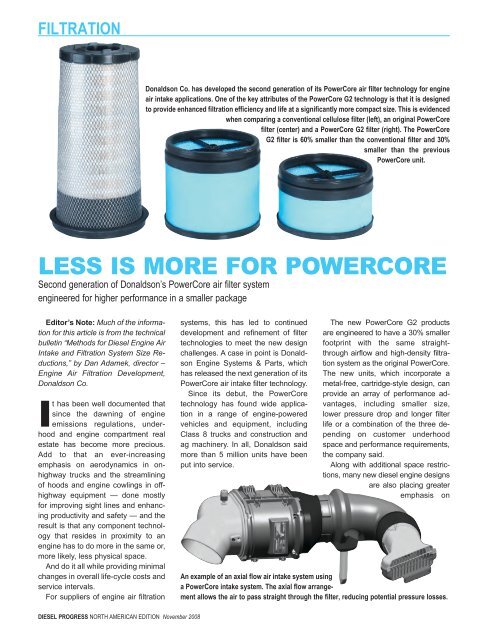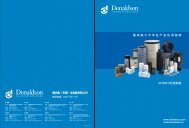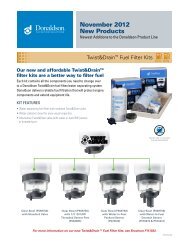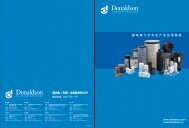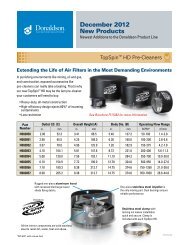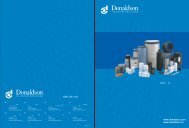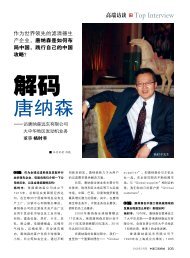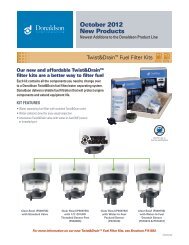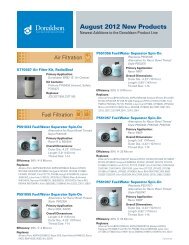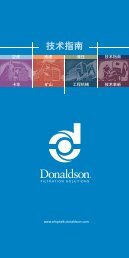LESS IS MORE FOR POWERCORE
LESS IS MORE FOR POWERCORE
LESS IS MORE FOR POWERCORE
Create successful ePaper yourself
Turn your PDF publications into a flip-book with our unique Google optimized e-Paper software.
FILTRATION<br />
Donaldson Co. has developed the second generation of its PowerCore air filter technology for engine<br />
air intake applications. One of the key attributes of the PowerCore G2 technology is that it is designed<br />
to provide enhanced filtration efficiency and life at a significantly more compact size. This is evidenced<br />
when comparing a conventional cellulose filter (left), an original PowerCore<br />
filter (center) and a PowerCore G2 filter (right). The PowerCore<br />
G2 filter is 60% smaller than the conventional filter and 30%<br />
smaller than the previous<br />
PowerCore unit.<br />
<strong>LESS</strong> <strong>IS</strong> <strong>MORE</strong> <strong>FOR</strong> <strong>POWERCORE</strong><br />
Second generation of Donaldson’s PowerCore air filter system<br />
engineered for higher performance in a smaller package<br />
Editor’s Note: Much of the information<br />
for this article is from the technical<br />
bulletin “Methods for Diesel Engine Air<br />
Intake and Filtration System Size Reductions,”<br />
by Dan Adamek, director –<br />
Engine Air Filtration Development,<br />
Donaldson Co.<br />
It has been well documented that<br />
since the dawning of engine<br />
emissions regulations, underhood<br />
and engine compartment real<br />
estate has become more precious.<br />
Add to that an ever-increasing<br />
emphasis on aerodynamics in onhighway<br />
trucks and the streamlining<br />
of hoods and engine cowlings in offhighway<br />
equipment — done mostly<br />
for improving sight lines and enhancing<br />
productivity and safety — and the<br />
result is that any component technology<br />
that resides in proximity to an<br />
engine has to do more in the same or,<br />
more likely, less physical space.<br />
And do it all while providing minimal<br />
changes in overall life-cycle costs and<br />
service intervals.<br />
For suppliers of engine air filtration<br />
systems, this has led to continued<br />
development and refinement of filter<br />
technologies to meet the new design<br />
challenges. A case in point is Donaldson<br />
Engine Systems & Parts, which<br />
has released the next generation of its<br />
PowerCore air intake filter technology.<br />
Since its debut, the PowerCore<br />
technology has found wide application<br />
in a range of engine-powered<br />
vehicles and equipment, including<br />
Class 8 trucks and construction and<br />
ag machinery. In all, Donaldson said<br />
more than 5 million units have been<br />
put into service.<br />
The new PowerCore G2 products<br />
are engineered to have a 30% smaller<br />
footprint with the same straightthrough<br />
airflow and high-density filtration<br />
system as the original PowerCore.<br />
The new units, which incorporate a<br />
metal-free, cartridge-style design, can<br />
provide an array of performance advantages,<br />
including smaller size,<br />
lower pressure drop and longer filter<br />
life or a combination of the three depending<br />
on customer underhood<br />
space and performance requirements,<br />
the company said.<br />
Along with additional space restrictions,<br />
many new diesel engine designs<br />
are also placing greater<br />
emphasis on<br />
An example of an axial flow air intake system using<br />
a PowerCore intake system. The axial flow arrangement<br />
allows the air to pass straight through the filter, reducing potential pressure losses.<br />
DIESEL PROGRESS NORTH AMERICAN EDITION November 2008
FILTRATION<br />
A schematic representation of how airflow moves through a PowerCore air filter.<br />
lower restrictions in the air intake system,<br />
as higher restrictions can increase<br />
the emissions levels being<br />
measured in the engine exhaust.<br />
Air intake system pressure losses<br />
have historically been a key design<br />
consideration, as they can have a<br />
negative impact on both performance<br />
and fuel economy. While it<br />
might seem minor — air intake<br />
restriction is estimated to have less<br />
than a 1% impact on fuel economy<br />
— the annual additional fuel usage<br />
with a sub-optimal air filter can easily<br />
exceed the original purchase price<br />
of the filter, Donaldson said. And with<br />
diesel fuel nearing $4 a gallon in<br />
many parts of the U.S., truck and<br />
equipment operators who burn thousands<br />
of gallons of fuel yearly are<br />
looking for any relief they can get,<br />
however incremental.<br />
Fuel savings also translate into<br />
reduced CO 2 emissions. While greenhouse<br />
gas emissions are not yet the<br />
focus of most existing diesel regulations,<br />
there seems little doubt that the<br />
case is being built for new federal<br />
standards. In the meantime, there are<br />
regions where taxation is based on<br />
vehicles’ emissions.<br />
When looking to reduce life-cycle<br />
costs related to air filters, efforts<br />
often take the form of either increasing<br />
the air filter’s life at equal cost or<br />
reducing the air filter cost at equivalent<br />
life. In some cases, vehicle and<br />
equipment manufacturers are looking<br />
for ways to reconfigure the air<br />
intake system layout to reduce cost.<br />
In on-highway trucks, for example,<br />
behind-the-cab air intake systems<br />
have become the answer to underhood<br />
space constraints. Size reductions<br />
in the system can allow for alternate<br />
configurations such as a frontal<br />
intake system. This can shorten the<br />
ductwork, thereby reducing costs,<br />
and also utilize the engine compartment<br />
to mitigate noise transmission<br />
through the inlet.<br />
The design of diesel engine air<br />
intake systems requires the integration<br />
of many technologies and the balancing<br />
of many factors, such as filter<br />
efficiency, filter life, restriction, size<br />
The normalized total<br />
media area for equalsized<br />
air filters, comparing<br />
the original<br />
PowerCore technology<br />
with PowerCore<br />
G2. Performance may<br />
vary depending on geometry<br />
and operating<br />
conditions, the company<br />
noted.<br />
Normalized Total<br />
Media Area<br />
140%<br />
120%<br />
100%<br />
80%<br />
60%<br />
40%<br />
20%<br />
0%<br />
and cost. In most cases, any aspect<br />
can be improved, usually through<br />
compromises in another property.<br />
For example, size can be reduced<br />
by reducing filter efficiency, reducing<br />
filter life or increasing filter pressure<br />
loss. Advancements in technology are<br />
required to achieve simultaneous<br />
improvement in multiple parameters.<br />
These technology advancements can<br />
take several forms, from simply improving<br />
via design and materials expertise,<br />
to the utilization of advanced<br />
tools such as computation fluid<br />
dynamics (CFD), to the development<br />
of breakthrough configurations.<br />
Other system requirements — such<br />
as noise attenuation, elevated temperature<br />
operation, chemical resistance,<br />
durability under vibration and<br />
shock, etc. — also need to be addressed<br />
during the design process as<br />
well. The ability to meet such a range<br />
of diverse challenges is mostly determined<br />
by the design and performance<br />
of the air filter.<br />
Engine wear rates have been calculated<br />
to decrease by a factor of 10<br />
when high-efficiency air filters are used<br />
in place of standard efficiency filters.<br />
Increased efficiency levels have been<br />
achieved primarily through the optimization<br />
of the fibrous structure of the<br />
filter media. The use of nanofibers on<br />
the media surface has allowed the<br />
thickness and density of the media to<br />
be reduced, thereby decreasing the<br />
pressure losses through the media<br />
and the amount of material used.<br />
Like the original PowerCore filters,<br />
the new PowerCore G2 filters utilize<br />
PowerCore<br />
PowerCore G2<br />
November 2008<br />
DIESEL PROGRESS NORTH AMERICAN EDITION
FILTRATION<br />
350%<br />
Normalized Dust<br />
Holding Capacity<br />
300%<br />
250%<br />
200%<br />
150%<br />
100%<br />
50%<br />
The normalized <strong>IS</strong>O fine dust capacity for<br />
equal-sized air filters. Again, performance<br />
may vary depending on geometry and<br />
operating conditions, the company said.<br />
0%<br />
Conventional<br />
Cylindrical<br />
PowerCore<br />
PowerCore<br />
G2<br />
Donaldson’s Ultra-Web Nanofiber Filtration<br />
technology. Ultra-Web has been<br />
used for more than 25 years in a range<br />
of heavy-duty industrial air filtration<br />
applications, and the company said it<br />
has sold more than 1 billion sq.ft. of the<br />
media since its initial development.<br />
Donaldson said the Ultra-Web nanofibers<br />
show high initial efficiency compared<br />
to conventional cellulose media,<br />
which only achieves its targeted efficiency<br />
level after it has built up a sufficient<br />
dust cake on its surface.<br />
The build-up of contaminants on the<br />
filter media causes pressure losses to<br />
increase over time, until it reaches a<br />
magnitude that is determined to be the<br />
maximum allowable by the engine.<br />
The ability of an air filter to load slowly<br />
provides for extended change intervals<br />
and is also important because the<br />
longer an engine operates at low<br />
restriction, the lower the average fuel<br />
consumption that can be achieved.<br />
For many years, cylindrical filters<br />
were the technology of choice, and<br />
the development in the 1980s of radial<br />
seal designs enabled the transition<br />
from metal air cleaner housings to<br />
polymeric housings, thereby greatly<br />
reducing product costs and improving<br />
product quality.<br />
When introduced in the following<br />
decade, Donaldson’s PowerCore<br />
technology incorporated an axial flow<br />
configuration that allowed the airflow<br />
to pass straight through the filter without<br />
the 90° change in direction seen<br />
in cylindrical filters, decreasing potential<br />
pressure losses within the air<br />
intake system.<br />
Axial flow filters have been widely<br />
adopted by OEMs, and the new<br />
PowerCore G2 products are designed<br />
to provide even greater levels of performance<br />
and efficiency, Donaldson<br />
said. The internal configuration of the<br />
PowerCore G2 filter has been optimized<br />
by reconfiguration of every<br />
geometric feature within the filter to<br />
reduce pressure losses and increase<br />
filter life, the company said.<br />
One challenge in air filter design —<br />
and particularly in axial-style filters —<br />
is the effort to minimize the media<br />
area that is unutilized or underutilized<br />
due to masking. PowerCore G2 is<br />
engineered to reduce media masking<br />
when compared to previous axial flow<br />
air filters, Donaldson said. Because<br />
increases in effective media area decrease<br />
the velocity though media, it<br />
has the dual effect of decreasing the<br />
pressure loss across the media and<br />
reducing the loading per unit area.<br />
This leads to a significant increase in<br />
filter life from relatively small increases<br />
in effective media area, the company<br />
noted.<br />
Additionally, Donaldson said that<br />
the PowerCore G2 has been designed<br />
to allow for increased total media area<br />
to be packaged into a filter through a<br />
proprietary media-forming process,<br />
which leads to increased filter life<br />
when combined with the correct filter<br />
channel configurations.<br />
Channel pressure losses can be<br />
lowered through increasing the air filter’s<br />
channel size, the company noted.<br />
This also decreases the amount of<br />
media, however, so the application requirements<br />
need to be factored into<br />
the choice of channel size, Donaldson<br />
said. Additionally, increases in channel<br />
space can also be obtained by utilizing<br />
thin filter media. Nanofiber laminates<br />
allow for thinner media because particulate<br />
efficiency increases as media<br />
fiber size decreases.<br />
Donaldson said that PowerCore G2<br />
configurations have been optimized in<br />
their development through use of advanced<br />
modeling tools that allowed<br />
comparison of the performance of millions<br />
of unique axial flow filter configurations.<br />
Prototypes of these selected configurations<br />
have been tested and validated<br />
against the theoretical models.<br />
The PowerCore G2 technology is<br />
available in panel, round and obround<br />
shaped air intake systems that can be<br />
customized to meet a wide spectrum<br />
of performance, size, shape and space<br />
constraints, the company said. dp<br />
REPRINTED FROM NOVEMBER 2008 DIESEL PROGRESS North American Edition<br />
Copyright Diesel & Gas Turbine Publications<br />
Printed in U.S.A.


